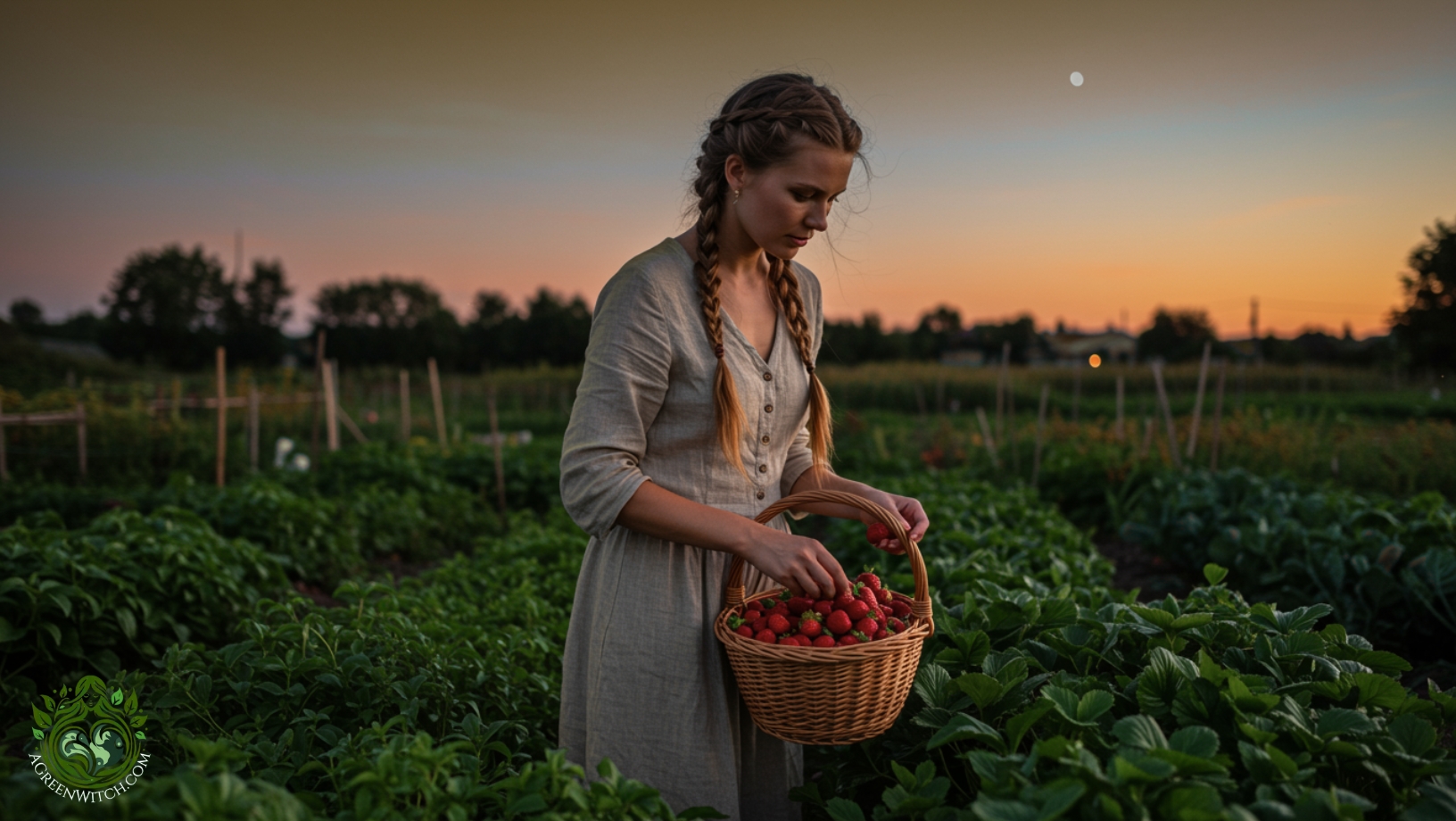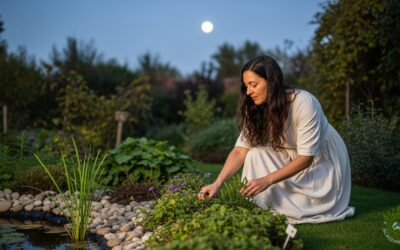The Sacred Wheel of the Garden: Celebrating the Sabbats Through Planting
Gardening with the Wheel of the Year invites us to become co-creators in an ancient story—one written in seed and soil, sun and shadow. This isn’t just seasonal planting; it’s a spiritual practice woven through with ancestral wisdom, lunar rhythms, and the sacred turning of time. Whether you’re a seasoned green witch or a curious beginner, aligning your garden with the Sabbats infuses every task—planting, pruning, harvesting—with deeper meaning.
The Sabbats mark more than seasonal milestones; they are spiritual gateways. From the quiet stirrings of Imbolc to the fiery abundance of Litha, from the reflective harvest of Mabon to the stillness of Yule, each celebration brings a unique energy. Gardening with the Wheel of the Year allows you to tune into these energies, turning your outdoor space into a living altar that evolves with the sun’s path and your own growth.
In this guide, we’ll explore what to plant, when to sow, and how to honor the energies of each Sabbat through ritual and herbal connection. You’ll discover how Gardening with the Wheel of the Year strengthens your intuition, fosters ecological awareness, and transforms your garden into a sacred space of intention, balance, and magic.
So gather your seeds, cleanse your tools, and take a breath. The Wheel is turning—and your garden is ready to turn with it.
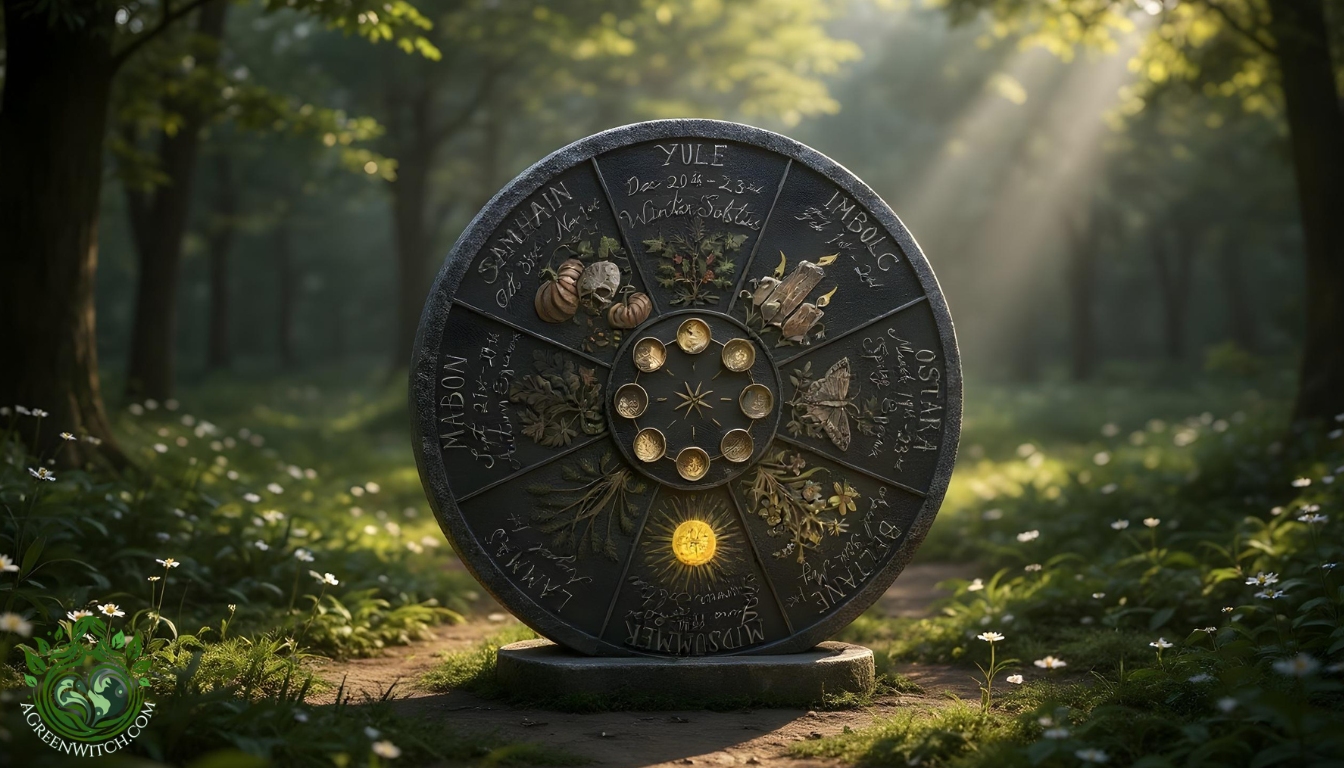
🌍 What Is the Wheel of the Year?
The Wheel of the Year is an ancient, Earth-based calendar that maps out the cyclical dance of the sun as it moves through the seasons. Rooted in Celtic, Norse, and Wiccan traditions, this sacred cycle honors eight key festivals—four solar celebrations (the solstices and equinoxes) and four cross-quarter fire festivals that fall in between. Together, these eight Sabbats form a complete circle that mirrors the rise, peak, decline, and rebirth of the natural world.
Unlike the linear, fast-paced calendars of modern life, the Wheel of the Year invites a slower, more intentional rhythm—one where we tune into the subtle shifts in light, temperature, and life force. Each Sabbat is both a spiritual checkpoint and a seasonal marker, offering wisdom, reflection, and guidance. When you begin gardening with the Wheel of the Year, you’re not just tending to plants—you’re participating in a sacred dialogue with the Earth.
At Imbolc, the earth begins to stir beneath the frost, whispering promises of new life. With Ostara, day and night meet in perfect balance, urging us to plant seeds—both literal and spiritual. Beltane erupts with fertility and passion, calling us to sow with wild abandon. By Litha, the longest day, gardens are lush and overflowing. As the wheel turns to Lammas and Mabon, we reap and give thanks, preparing for the descent into shadow. Samhain bids farewell to the growing season, and Yule welcomes the return of the sun—each festival a thread in the tapestry of time.
Gardening with the Wheel of the Year allows us to synchronize our planting, harvesting, and seasonal rituals with these ancient rhythms. Instead of resisting the natural shifts—like trying to grow summer crops in early spring or ignoring the need for rest in winter—we learn to move in harmony with nature’s innate wisdom. This practice cultivates not only a more sustainable and productive garden but also a deeper spiritual connection to the land and ourselves.
In many ways, the Wheel is a compass—not just for the Earth’s cycles, but for our personal journeys. It reminds us that just like our gardens, we too have seasons of growth, bloom, harvest, and rest. By gardening with the Wheel of the Year, we begin to recognize these inner seasons and honor them, planting not just vegetables and herbs, but also intentions, healing, and magic.
Whether you are a seasoned herbalist, a weekend gardener, or someone just starting to explore the path of the green witch, the Wheel of the Year offers a powerful framework. It transforms the garden from a chore into a ritual, from a task into a celebration. And most importantly, it roots us—deeply and lovingly—in the sacred cycles of the Earth.
🌿 Why Garden with the Wheel of the Year?
In today’s fast-paced world, it’s easy to become disconnected from the Earth’s natural rhythms. We often find ourselves gardening according to convenience or commercial cues rather than intuition and seasonality. But gardening with the Wheel of the Year invites us to slow down, observe, and root our practices in something much older and wiser—nature’s own timekeeping.
This sacred approach to gardening offers more than practical advice—it provides a spiritual framework. With every turn of the Wheel, we are offered an opportunity to not only plant what’s seasonally appropriate but to cultivate meaning, mindfulness, and magic in the soil we tend. Here’s why aligning your garden with the Wheel of the Year can be truly transformative:
🌿 Seasonal Alignment
Each Sabbat represents a distinct shift in the Earth’s energy, sunlight, and fertility. By tuning into these changes, you’ll learn exactly what your garden is ready for—whether that’s sowing seeds in early spring, nurturing blossoms in high summer, or allowing the soil to rest in the depths of winter. Nature tells us what thrives and when—if we listen, our gardens flourish.
Gardening with the Wheel of the Year encourages us to observe temperature changes, moon cycles, and soil conditions. Instead of forcing a planting schedule, we work in partnership with the Earth, which often leads to healthier plants, fewer pests, and more abundant harvests.
🌙 Spiritual Connection
Every Sabbat holds its own spiritual significance. Imbolc whispers of renewal. Ostara brings balance and fertility. Beltane blazes with passion and vitality, while Samhain calls for rest and release. When we garden in sync with these energies, we deepen our connection not only to the Earth but also to our ancestors, the spirit of place, and our higher selves.
Planting with purpose—whether it’s a rosemary bush for remembrance or lavender for protection—transforms a mundane act into a sacred offering. Through gardening with the Wheel of the Year, our gardens become mirrors of our inner lives, reflecting our hopes, growth, challenges, and evolution with each passing season.
Additional Reading: Rewilding for Spiritual Growth
✨ Intentional Living
There is something deeply grounding about planting seeds on Ostara morning or harvesting calendula at the height of Litha’s sun. These acts, when done in rhythm with the Wheel, become rituals. They reconnect us to the land, the seasons, and ourselves.
Aligning your planting schedule with the Sabbats fosters mindfulness. It asks you to pause before you dig, to breathe before you sow, to bless before you water. Over time, gardening with the Wheel of the Year invites a quieter, more reflective approach to life—one rooted in cycles rather than schedules.
🌺 Your Garden as Sacred Space
When you garden with intention, your outdoor space transforms. It’s no longer just a vegetable patch or a flower bed—it becomes a living altar. Your actions in the garden—planting, pruning, composting, harvesting—become acts of devotion and celebration. This isn’t just sustainable gardening; it’s sacred gardening.
By gardening with the Wheel of the Year, your garden evolves into a spiritual ecosystem. You’ll find yourself blessing the soil at Yule, honoring pollinators at Beltane, and returning your harvest offerings to the land at Mabon. It becomes a dialogue with the divine, a ritualized return to reverence for the Earth.
Ultimately, gardening in this way is about more than just producing food or flowers—it’s about cultivating a relationship with the land. It’s about listening to the whispers of the seasons, honoring the turning of time, and remembering that we, too, are part of nature’s sacred cycle.
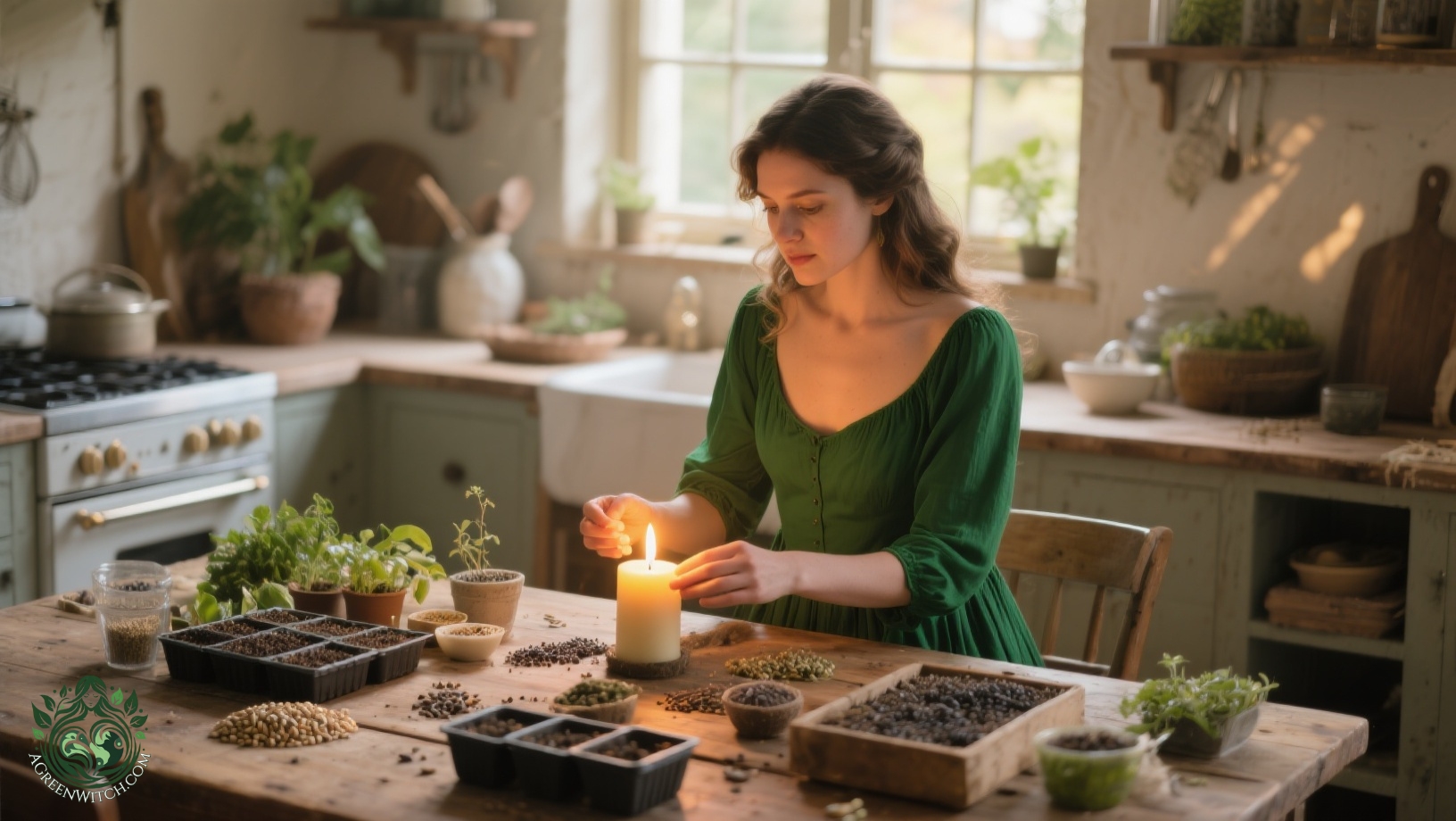
🕯️ Imbolc (February 1–2): The Spark of New Life
Imbolc arrives in the quiet hush of deep winter, when snow still blankets the ground, yet the days are perceptibly growing longer. Celebrated on February 1st or 2nd, Imbolc marks the midpoint between the winter solstice (Yule) and the spring equinox (Ostara). It is a festival of light, purification, and promise—a sacred threshold where winter begins to loosen its grip and the Earth prepares to stir beneath the surface.
This Sabbat is closely associated with the Celtic goddess Brigid, a deity of hearth, healing, poetry, and fertility. As the guardian of sacred wells and holy flames, Brigid brings inspiration and rebirth to both spirit and soil. For those practicing gardening with the Wheel of the Year, Imbolc is the perfect time to plant symbolic seeds—not just for your garden, but for the year ahead.
🌱 What to Plant at Imbolc
Though the earth may still seem dormant, Imbolc is the ideal time to begin indoor planting. The seeds you sow now carry the energy of hope, intention, and quiet anticipation.
- Cold-hardy seeds indoors: Kale, broccoli, cabbage—start these early in seed trays or small pots on a sunny windowsill or under grow lights.
- Medicinal herbs: Chamomile, lavender, and lemon balm can be started from seed or cuttings. These herbs are perfect for creating healing salves and calming teas later in the year.
- Spring bulbs: Daffodils and snowdrops are traditionally linked to Imbolc and can be prepped indoors if not already in the ground.
By choosing cool-weather crops and gentle healing herbs, you are aligning your garden with the season’s energy of nurturing beginnings. This is the essence of gardening with the Wheel of the Year—planting not just for food, but for spirit, ritual, and rebirth.
🔥 Ritual Gardening Tips for Imbolc
Imbolc is a festival of light, so illumination—both literal and metaphorical—is key. Whether your garden is slumbering beneath snow or you’re tending to houseplants and seed trays indoors, you can honor this Sabbat through simple, sacred gardening rituals.
- Light candles in your greenhouse, near your seed trays, or at the garden’s edge to symbolize the returning sun. Use white, gold, or green candles to represent purity, light, and growth.
- Infuse intention into your planting by writing your gardening hopes for the year—abundance, healing, protection—on popsicle sticks or seed markers. Place them in your pots or seed-starting trays as symbolic blessings.
- Bless your tools by washing them in warm water infused with rosemary, a plant long associated with purification and protection. As you clean them, thank them for their service in seasons past.
These small acts of reverence turn everyday gardening into ritual. In gardening with the Wheel of the Year, Imbolc becomes more than a date—it becomes an invitation to plant hope and awaken your garden soulfully, even before the ground thaws.
🌿 Herbal Lore of Imbolc
Herbs and flowers connected to Brigid and the early spring season are powerful allies for ritual and intention setting. You don’t need a large herb garden to begin incorporating these magical plants—just a few pots on a windowsill will do.
- Angelica: A sacred plant of protection and healing, often used in teas and charms. It’s associated with inspiration and spiritual strength.
- Coltsfoot: One of the first flowers to bloom after snow, coltsfoot brings renewal and clarity. Use dried leaves in incense blends or dream pillows.
- Heather: Linked to Brigid, this plant symbolizes resilience and beauty emerging from the cold. Place heather near entryways or in garden beds to invite blessings.
Create herbal sachets with these dried plants to place on your altar or hang near your garden tools. You can also brew a simple tea with lemon balm and chamomile to sip as you set your gardening intentions for the year. As with all practices in gardening with the Wheel of the Year, the goal is connection—between you, the plants, the soil, and the season.
🌸 Imbolc Affirmation for the Garden
“I plant with hope and tend with love. In the stillness of winter, I sow the light of spring to come.”
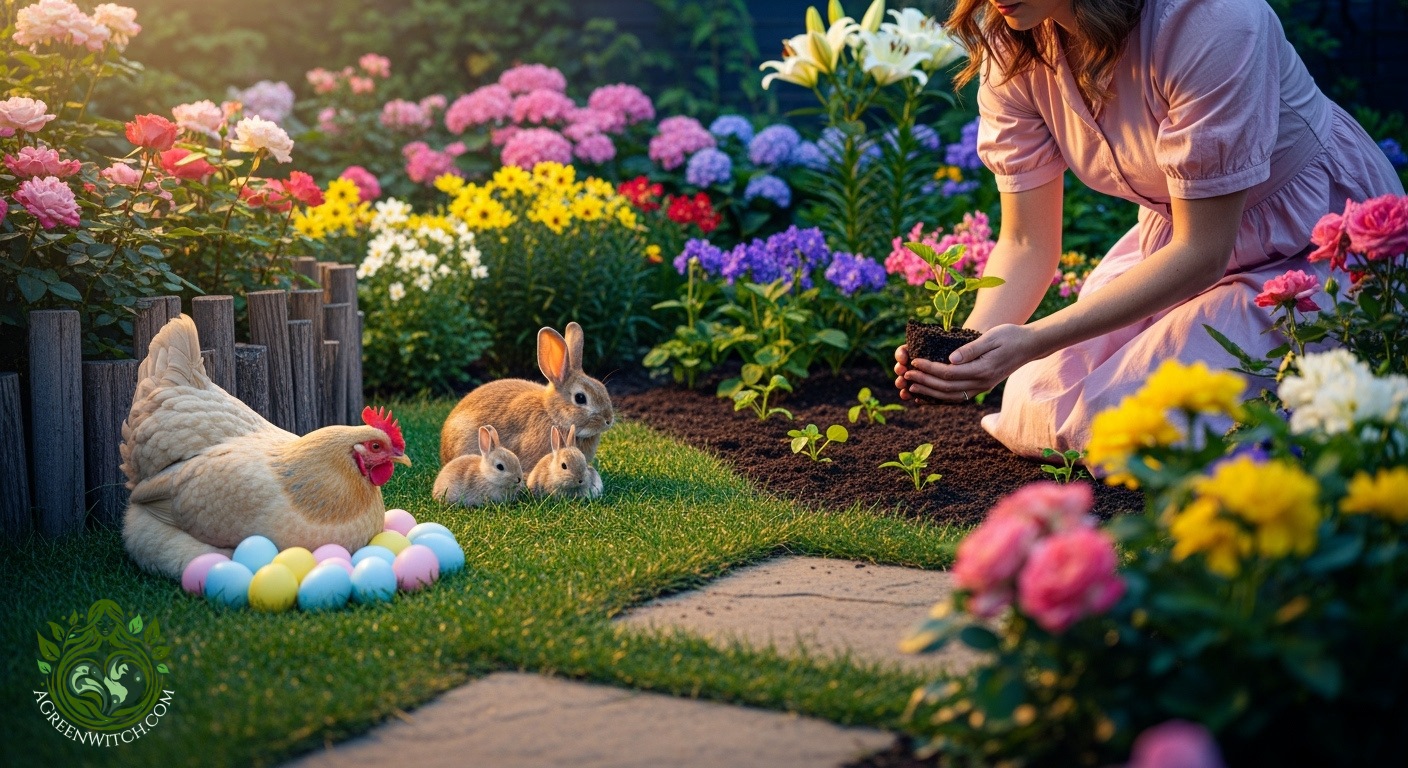
🌸 Ostara (Spring Equinox – March 20–23): Planting Balance
Ostara arrives with the vernal equinox, a powerful moment of cosmic equilibrium when day and night are perfectly balanced. Named after the Germanic goddess Eostre, whose symbols include eggs, hares, and blooming flowers, Ostara celebrates fertility, rebirth, and the triumphant return of life. It is a joyful and generative time, when the Earth begins to shake off winter’s slumber and the garden bursts with potential.
For those gardening with the Wheel of the Year, Ostara is a pivotal Sabbat. It marks the true beginning of the planting season—when the soil begins to warm, daylight lengthens, and the energy of renewal is palpable in every budding branch and chirping bird. It’s a time to sow seeds both in the soil and in the spirit, cultivating not only crops but balance, clarity, and joyful intention.
🌿 What to Plant at Ostara
Ostara is the perfect time to begin sowing early spring crops, especially cool-weather vegetables and frost-tolerant flowers. The garden is no longer a place of dormancy—it becomes a canvas of green possibility.
- Cool-weather vegetables: Peas, lettuce, and radishes thrive in the brisk, moist soil of early spring. Sow directly into your garden beds or raised containers.
- Early flowers: Pansies, primrose, and violets bring color and pollinator-friendly blooms to your garden while withstanding unpredictable temperatures.
- Companion planting: Begin mapping out your garden companions. Plant marigolds near tomatoes to deter pests, and place basil near peppers for mutual vitality.
These foundational plantings help you build a strong, healthy garden from the ground up. In gardening with the Wheel of the Year, Ostara teaches us that balance in the garden—between sun and shadow, moisture and drainage, growth and rest—yields harmony in life.
🌼 Ritual Gardening Tips for Ostara
Ostara is rich with symbolism, especially that of the egg—a timeless emblem of life emerging from dormancy. Incorporating ritual into your garden during this Sabbat can help you align more deeply with the Earth’s energy and awaken your own inner vitality.
- Decorate eggs with plant-based dyes using herbs, beets, turmeric, or red cabbage. Bury these sacred eggs near newly sown seeds as offerings of fertility and blessings for abundant growth.
- Create a spiral herb garden using stones, bricks, or natural edging to reflect the Wheel of the Year itself. Fill it with herbs that thrive in different microclimates—thyme, parsley, chives, and sage are wonderful starters.
- Offer seeds and honey on small leaf plates or stones to honor bees, butterflies, and birds. These sacred pollinators are the lifeblood of the garden, and offerings call them back with gratitude.
When gardening with the Wheel of the Year, every small act of planting becomes a sacred rite. You’re not simply preparing beds—you’re invoking the energy of balance, beauty, and new beginnings.
🍀 Herbal Lore of Ostara
The herbal allies of Ostara are vibrant, wild, and overflowing with life-force energy. These are plants that sprout quickly, offer nourishment, and symbolize fertility and renewal.
- Nettles: Among the first wild greens of spring, nettles are rich in iron and vitality. Harvest with gloves and respect. Add to teas, soups, or as a cooked green for purification and energy.
- Clover: Associated with luck, balance, and heart healing. Clover can be added to garden borders and used in herbal salves or tinctures for skin and immune support.
- Dandelion: A sacred plant of the sun, dandelion’s bitter greens support digestion and detoxification. Harvest young leaves for spring tonics, or make a wish on its golden flowerheads.
Use these herbs fresh or dried in Ostara altar bundles, garden teas, or incense. In the practice of gardening with the Wheel of the Year, they remind us to value what grows wild, humble, and overlooked—because it often carries the most potent magic.
🌞 Ostara Affirmation for the Garden
“I sow with clarity and balance. As the Earth awakens, so do I. My garden and spirit grow in harmony.”

🔥 Beltane (May 1): The Garden Ignites
As the Wheel turns toward Beltane, the Earth is fully awake and overflowing with vitality. Celebrated on May 1, Beltane is a fire festival that honors fertility, sensuality, and the lushness of life. Named from the Celtic words “Bel” (bright) and “tene” (fire), this Sabbat is a celebration of union—between sun and soil, blossom and bee, desire and creation.
In gardening with the Wheel of the Year, Beltane is the moment when the garden begins to truly hum with energy. The air is scented with blooms, pollinators dance through the flowers, and the soil is warm enough to welcome more delicate seedlings. This is a time to plant with passion and intention, to invite abundance through both action and ritual.
🌱 What to Plant at Beltane
Beltane’s fertile energies encourage planting crops that need warmth and a long growing season. It’s the ideal time to start summer’s staples and to sow plants that thrive on heat and sun.
- Warm-season vegetables: Tomatoes, peppers, cucumbers, zucchini, and corn can all be transplanted or sown now in most zones.
- Nightshades and climbers: Eggplants, beans, and gourds love the Beltane soil and respond well to the fire festival’s intensity.
- Magical herbs: Mugwort, yarrow, and vervain—herbs of prophecy, protection, and passion—can be planted now to align with Beltane’s fiery essence.
In gardening with the Wheel of the Year, Beltane is about honoring life force. Planting now invites not only physical nourishment, but the blossoming of joy, creativity, and pleasure into your garden and your daily rituals.
🔥 Ritual Gardening Tips for Beltane
Beltane is the most sensual of Sabbats, and its garden rituals are celebratory, tactile, and deeply embodied. This is a wonderful time to infuse your planting with beauty, movement, and heart-centered intention.
- Dance in the garden: Celebrate the fertility of the land by dancing barefoot around a maypole or spiral made of flower petals and herbs.
- Build a Beltane altar: Use fresh flowers, greenery, and small flames (tea lights in jars) to honor the energies of fire and growth.
- Plant with a partner or loved one: Beltane is about union. Sow seeds with someone you care about to amplify connection and shared intention.
- Offer milk and honey: Pour a small offering at the base of a blooming tree or near newly sown seeds to invite fertility and sweetness into your garden.
When gardening with the Wheel of the Year at Beltane, the act of planting becomes a spell of abundance. You’re not just nurturing vegetables or herbs—you’re calling in love, vitality, and wild growth in all forms.
🌼 Herbal Lore of Beltane
Beltane’s herbs are associated with passion, protection, and divination. These plants hold stories of sacred marriage between Earth and Sky, and their energy supports you in thriving and blossoming alongside your garden.
- Hawthorn: A sacred tree of Beltane, hawthorn is linked to the heart, protection, and love magic. Its blossoms can be dried for teas or used in garlands to bless the garden gate.
- Rosemary: A symbol of remembrance and clarity, rosemary strengthens plant companions and human focus alike. Use in wreaths or hang near your garden to protect sacred spaces.
- Mugwort: Known for enhancing dreams and intuition, mugwort can be planted near garden paths or dried for smudging bundles to clear stagnant energy.
Using these plants during Beltane supports the energetic balance of your space. In the practice of gardening with the Wheel of the Year, they invite both mystical insight and rooted practicality into your seasonal rhythms.
🌸 Beltane Affirmation for the Garden
“I plant with passion and joy. My garden blooms with love, pleasure, and purpose. I am a co-creator of abundance.”
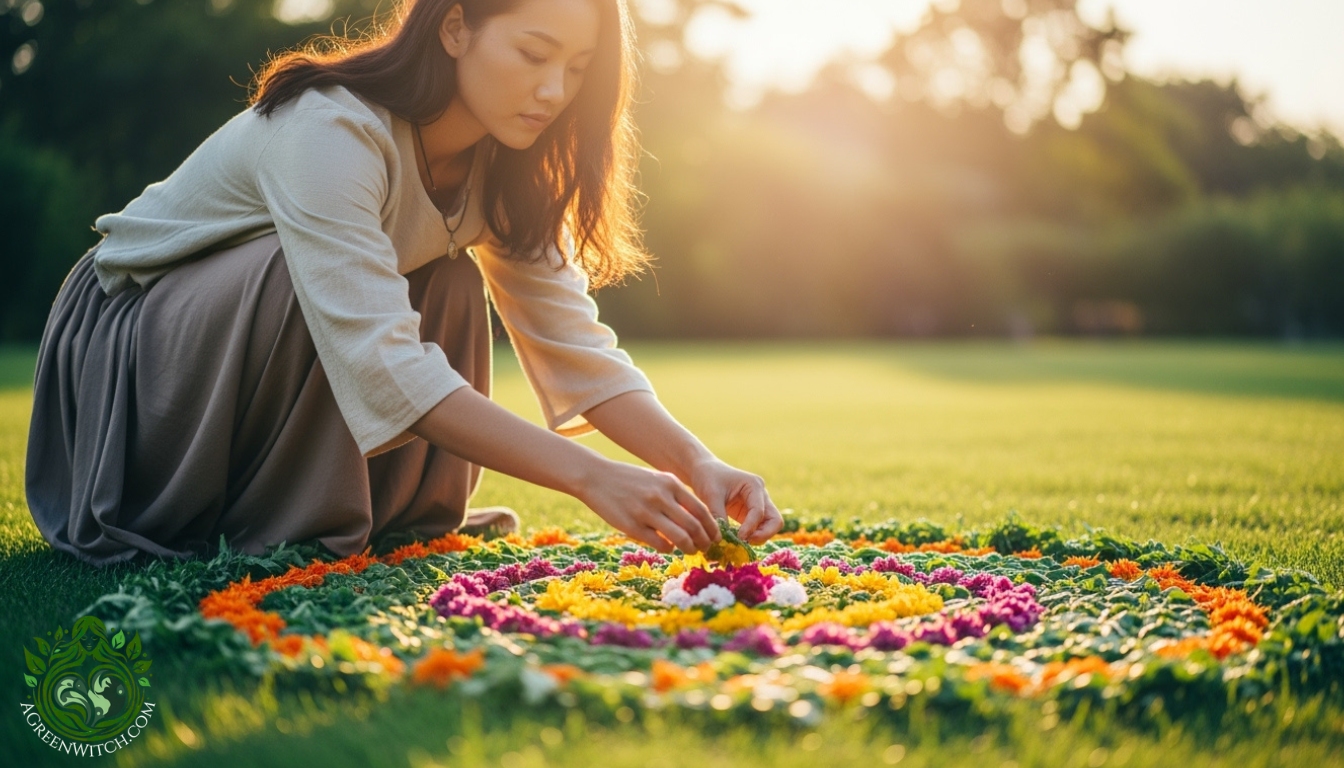
☀️ Litha (June 20–23): The Sun at Its Peak
Litha, also known as the Summer Solstice, marks the longest day of the year and the height of the sun’s power. As the Wheel turns to its zenith, the garden is bathed in golden light, bursting with color, fragrance, and buzzing life. This is a celebration of fire, fruitfulness, and full manifestation.
When gardening with the Wheel of the Year, Litha is the time to honor everything that has taken root—literally and energetically. What began as seeds at Imbolc and sprouted with Ostara now reaches its full bloom. It’s a time to give thanks for your garden’s progress, to tend with love, and to invite the sun’s radiant energy into your plants, home, and heart.
🌻 What to Plant at Litha
While the bulk of planting may already be done by midsummer, there are still crops and herbs that thrive when sown now. Litha is also the perfect time to succession plant and to begin preparing your space for late-summer and fall harvests.
- Second sowing: Beans, carrots, beets, and squash can all be planted now for an extended harvest.
- Heat-loving herbs: Basil, oregano, thyme, and sage love the warmth and will thrive with regular harvesting.
- Pollinator plants: Sunflowers, calendula, and echinacea not only beautify the space but also attract bees and butterflies to support your garden’s ecosystem.
Gardening with the Wheel of the Year during Litha means working with the sun, not against it—planting what thrives in heat and ensuring your garden is a sanctuary for life and light.
🌞 Ritual Gardening Tips for Litha
Litha rituals are radiant and full of joy. This Sabbat invites you to honor the sun, tend to the fruits of your labor, and set intentions for the second half of the year.
- Create a sun wheel: Lay out flowers and herbs in a circular mandala on your garden altar or lawn to honor the solar peak.
- Harvest with gratitude: Begin harvesting herbs and early fruits while offering thanks aloud for each plant’s gift.
- Bless your garden with sunlight: Use a mirror or crystal to reflect sunlight onto key plants as a symbolic blessing of vitality.
- Light a Litha fire: A small bonfire or candle ritual at sunset helps carry the solar energy into the garden spirit. Whisper your gratitude and goals into the flames.
By gardening with the Wheel of the Year, Litha becomes more than just a solstice—it becomes a personal celebration of radiance, abundance, and sacred tending.
🌿 Herbal Lore of Litha
Many plants gathered on or around the Summer Solstice are said to carry heightened magical and medicinal potency. Drying and storing herbs now preserves the sun’s healing power for the darker months ahead.
- St. John’s Wort: This bright yellow flower is a classic Litha herb, used for warding off negativity and supporting mood and protection.
- Lavender: Ruled by Mercury and the sun, lavender brings calm, clarity, and protection. Hang dried bundles near garden gates or in the home.
- Chamomile: Harvest flowers at midday for calming teas and to invite peace into your sacred space.
Including these herbs in your Litha garden deepens your connection to solar magic. When gardening with the Wheel of the Year, the herbs you grow become allies in both healing and ritual practice.
☀️ Litha Affirmation for the Garden
“I honor the light within and around me. My garden blooms with radiant joy and endless potential.”
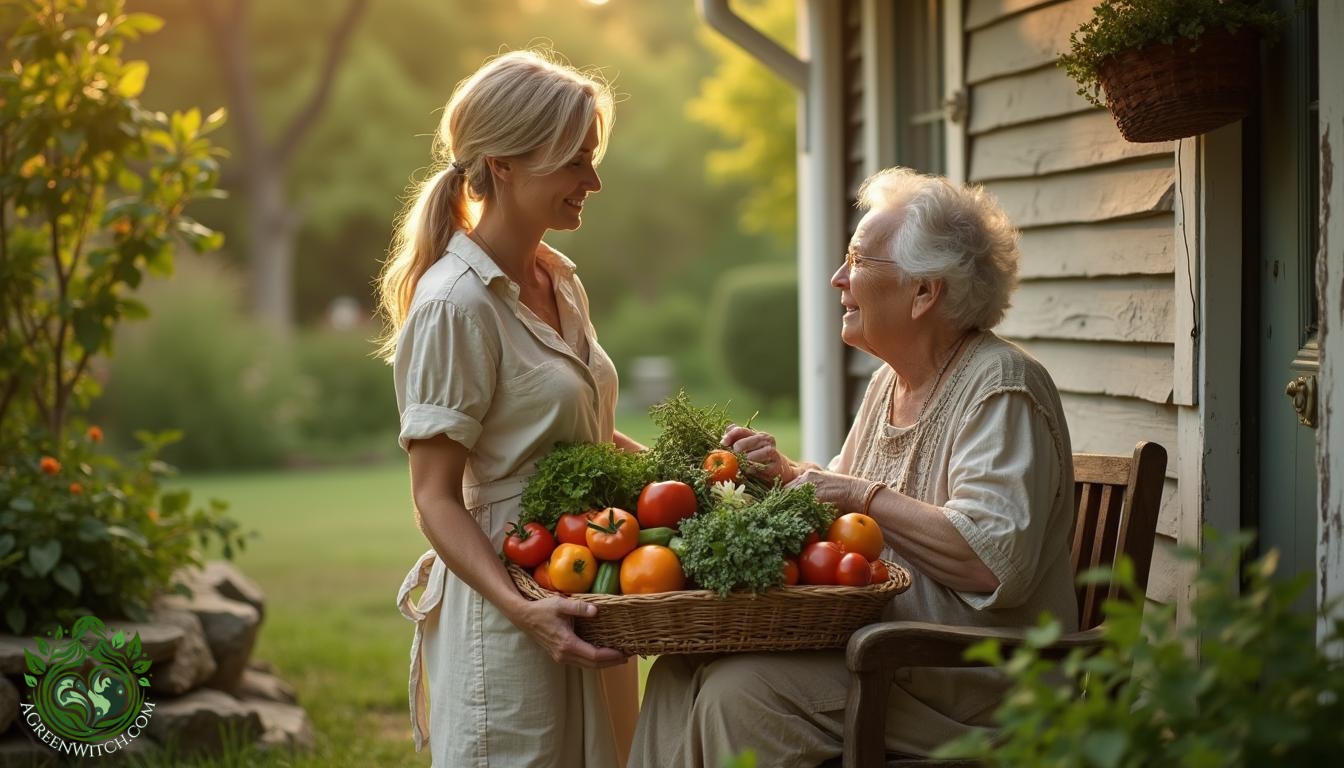
🌾 Lughnasadh / Lammas (August 1): The First Harvest
Lughnasadh—also known as Lammas—is the first of the three traditional harvest festivals on the Wheel of the Year. Named after the Celtic sun god Lugh, this Sabbat is a celebration of grain, abundance, and the rewards of dedication. The fields are golden, the fruits are ripening, and the garden begins to return its gifts.
For those practicing gardening with the Wheel of the Year, Lughnasadh is a deeply fulfilling moment. You begin to see the literal and metaphorical fruits of your labor. It’s a time to reflect on the energy you’ve poured into your garden and your intentions—and to give thanks.
🌻 What to Plant at Lughnasadh
Though harvesting is central to Lammas, there are still plants to sow if you want a strong autumn garden. Lughnasadh offers a final opportunity for late-season crops and herbs that prefer cooling temperatures.
- Fall vegetables: Start brassicas like kale, broccoli, and cabbage now to harvest before frost.
- Quick-growing crops: Sow lettuces, radishes, and arugula for speedy yields before the Equinox.
- Overwintering herbs: Parsley, cilantro, and dill can establish now for use into early winter.
Continue gardening with the Wheel of the Year by tuning into the energy of maturity and gratitude—what you plant now is infused with the wisdom of the season.
🌾 Ritual Gardening Tips for Lammas
Lughnasadh invites acts of sacred gratitude, community sharing, and honoring the land that nourishes you. Your garden is now a temple of abundance—and a reminder that life is a cycle of give and receive.
- Bake garden bread: Use herbs or grains from your harvest to bake a ritual loaf as an offering to the land.
- Create a harvest altar: Adorn it with sunflowers, corn, squash, and herbs to symbolize your gratitude.
- Share your bounty: Gift vegetables or herbal bundles to friends, neighbors, or pollinators.
- Make seed blessings: Choose seeds from your best plants, bless them in the sun, and store them for next Imbolc.
By gardening with the Wheel of the Year, your harvest becomes more than food—it becomes a spiritual exchange with the land, a covenant of abundance.
🌿 Herbal Lore of Lughnasadh
At Lammas, the healing properties of herbs are tied to themes of strength, sustenance, and gratitude. This is the time to preserve, dry, and prepare herbal medicines for the colder months ahead.
- Mugwort: Often burned for divination and protection, mugwort is also useful for teas that support dreams and digestion.
- Sage: As a sacred cleanser, sage helps clear energy and prepare both home and garden for transition.
- Yarrow: Known as a warrior’s herb, yarrow supports immunity and resilience—both physically and energetically.
Use these herbs to anoint tools, make smudge bundles, or dry for winter teas. Gardening with the Wheel of the Year ensures your herbal harvest is timely, magical, and aligned with Earth’s rhythms.
🌻 Lammas Garden Affirmation
“I honor the bounty before me and the work behind me. My garden is a living blessing, and I receive its gifts with gratitude and grace.”

🍁 Mabon (September 20–23): The Autumn Equinox and Balanced Harvest
Mabon, the second harvest festival and the Autumn Equinox, is a sacred moment of perfect balance—day and night once again equal in length, but the year’s light begins to wane. It is a time of thanksgiving, reflection, and preparation for the darker half of the year. Named after a figure from Welsh mythology, Mabon invites us to pause and honor the fruits we have gathered, while turning our hearts to rest and restoration.
When gardening with the Wheel of the Year, Mabon is a season of both harvest and stewardship. It asks us to reap what we have sown with gratitude, store wisely, and prepare our soil and spirits for the coming quiet. This equinox energy is both grounding and magical, reminding us that endings and beginnings are always intertwined.
🌾 What to Plant at Mabon
While many gardens begin to slow down, Mabon still offers opportunities for planting and renewal. This is an ideal time to sow cover crops that replenish the soil and to plant herbs and vegetables suited for cooler, shorter days.
- Cover crops: Clover, rye, and vetch enrich your soil with nutrients and protect it from erosion over winter.
- Fall greens: Spinach, Swiss chard, and arugula thrive in the cooling temperatures and can be harvested into late autumn.
- Herbs for resilience: Rosemary, thyme, and sage planted now will strengthen and flavor your garden into the colder months.
In the spirit of gardening with the Wheel of the Year, Mabon encourages mindful stewardship—planting not only for this season’s bounty but also for the health and vitality of your garden next year.
🍂 Ritual Gardening Tips for Mabon
Mabon rituals emphasize gratitude and balance, both in the garden and within ourselves. This is a powerful time to honor the harvest, reflect on cycles, and make peace with endings.
- Create a gratitude altar: Use harvested fruits, nuts, and autumn leaves to decorate a special space where you can meditate on your garden’s gifts.
- Harvest seeds: Collect seeds from your healthiest plants to preserve for next year’s planting, blessing them as symbols of continuity and hope.
- Prepare your soil: Compost garden waste and apply mulch to protect roots through winter, nurturing the earth in preparation for rebirth.
- Reflect and journal: Spend quiet time in your garden, journaling about your growth and goals, connecting deeply with the rhythms of nature.
Practicing gardening with the Wheel of the Year at Mabon helps you cultivate gratitude for your garden’s abundance while planting seeds of renewal for the future.
🌿 Herbal Lore of Mabon
Mabon’s herbs are those that support balance, healing, and endurance as the year shifts toward darkness. Harvest and preserve these plants to carry the garden’s spirit into winter.
- Marigold: Known for its protective and healing properties, marigold flowers brighten the autumn garden and can be used in salves and teas.
- Hawthorn: Symbolizing heart health and protection, hawthorn berries and leaves can be harvested for tonics that support the circulatory system.
- Fennel: A digestive aid and garden companion, fennel seeds can be collected and stored for winter use.
In gardening with the Wheel of the Year, these herbs become vital allies, bridging the gap between the waning light and the coming rest.
🍁 Mabon Garden Affirmation
“I honor the gifts of the earth and the lessons of the season. My garden’s bounty nourishes body and soul, and I prepare with grace for what is to come.”
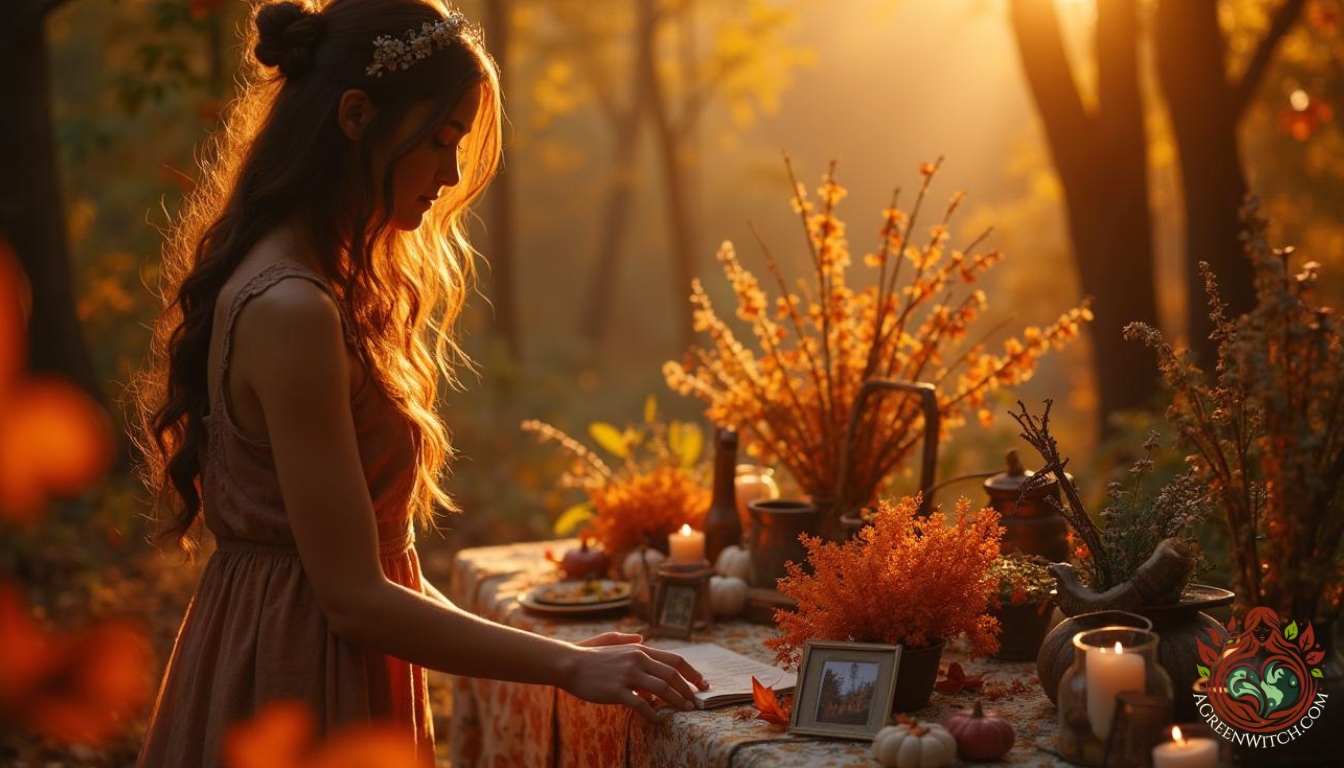
🌙 Samhain (October 31): Honoring the Cycle of Death and Renewal
Samhain, often called the Celtic New Year, marks the turning point between the light half and dark half of the year. Celebrated on October 31st, it is a sacred time to honor ancestors, acknowledge the thinning veil between worlds, and reflect on endings that lead to new beginnings. The garden, too, slows its growth and prepares for rest, mirroring the deep cycles of death and renewal in nature.
In the practice of gardening with the Wheel of the Year, Samhain invites profound reflection and preparation. It is a time to clear the old, compost last season’s remains, and plant the seeds of future intentions—both literal and spiritual. This is the gateway to the dark season, a liminal space where transformation is possible.
🍂 What to Plant at Samhain
Though the growing season has mostly ended, Samhain is an excellent time to plant bulbs and cover crops that will rest underground until spring.
- Spring-flowering bulbs: Daffodils, tulips, crocus, and snowdrops planted now sleep beneath the soil, quietly gathering strength for their spectacular spring debut.
- Cover crops: Clover, winter rye, and vetch improve soil fertility and structure during the cold months.
- Garlic and shallots: Plant now to harvest in late spring or early summer, adding flavor and health to your kitchen and garden.
Through gardening with the Wheel of the Year at Samhain, you honor the necessary pause and trust in the hidden growth that happens beneath the surface.
🌑 Ritual Gardening Tips for Samhain
Samhain’s rituals are deeply rooted in honoring ancestors and embracing cycles of death and rebirth.
- Create an ancestral garden altar: Use autumn leaves, dried herbs, photos, and tokens to honor those who came before you.
- Plant remembrance herbs: Sow rosemary, rue, or sage as living memorials and protectors of your sacred space.
- Compost respectfully: Return the garden’s remains to the earth with gratitude, recognizing the cycle of life, death, and renewal.
- Write intentions: Reflect on what you want to release and what you wish to cultivate in the coming year, planting those intentions as seeds of transformation.
When gardening with the Wheel of the Year, Samhain becomes a sacred time to honor endings, making space for new growth both in the garden and in your life.
🌿 Herbal Lore of Samhain
The herbs of Samhain help bridge worlds and support transformation and protection during the dark months.
- Mugwort: Used for dreamwork, protection, and enhancing psychic abilities—perfect for the veil-thinning energy of Samhain.
- Wormwood: A potent herb for cleansing and banishing negative energy, often burned as incense.
- Rue: Traditionally planted around homes and gardens for protection and purification.
These plants support the sacred work of releasing and renewing that is central to gardening with the Wheel of the Year during Samhain.
🌙 Samhain Garden Affirmation
“I honor the endings that bring new beginnings. My garden rests in darkness, preparing for the light to return.”
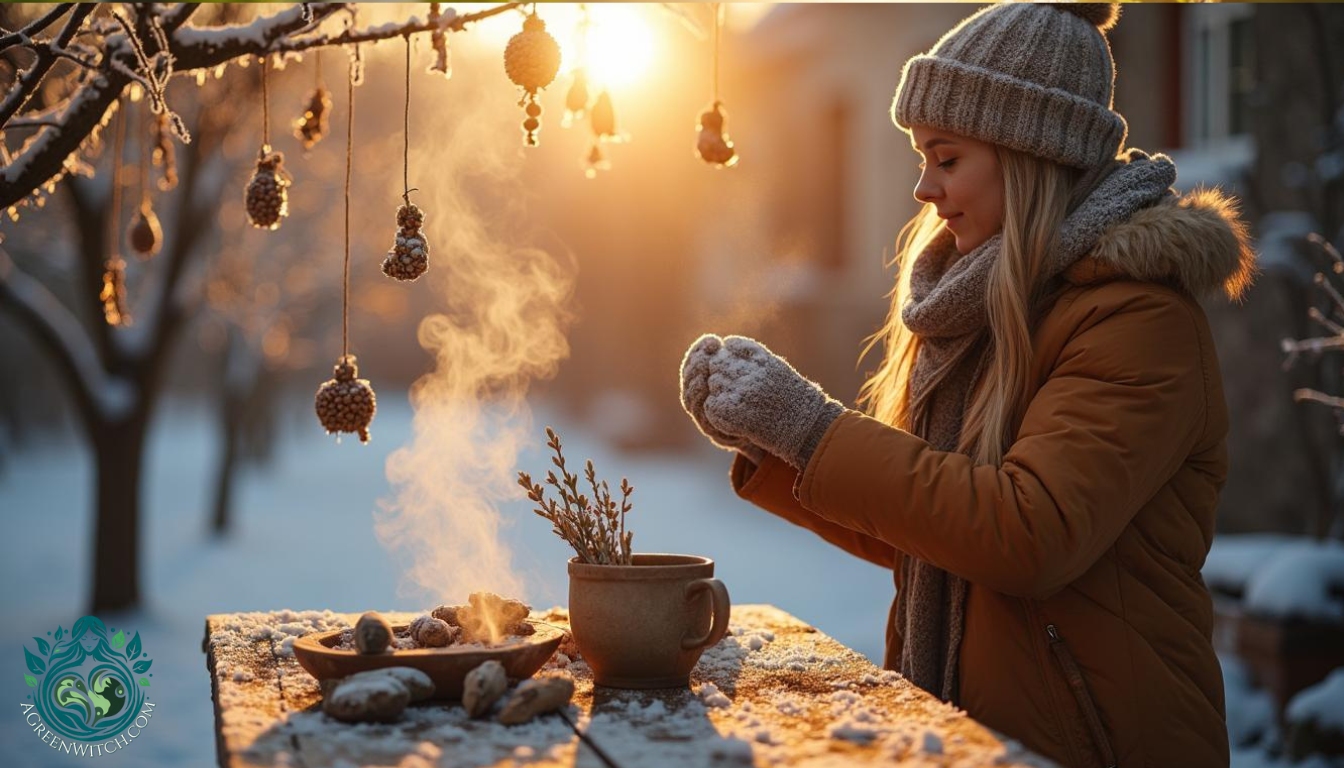
❄️ Yule (Winter Solstice – December 20–23): The Garden Sleeps
Yule, the Winter Solstice, marks the darkest night and the rebirth of the sun. It is a time of profound stillness and sacred waiting as the Earth’s energies turn inward, preparing for the return of light. Though the garden lies mostly dormant beneath frost and snow, the seeds of future growth are quietly gathering strength underground and in our intentions.
For those practicing gardening with the Wheel of the Year, Yule offers a chance to nurture inner patience and honor the cycles of rest and renewal. It’s a sacred pause—a moment to prepare both your garden and spirit for the coming seasons of growth and abundance.
🌿 What to Plant at Yule
While the outdoor garden rests, Yule is the perfect time to nurture life indoors and plan ahead for the coming year’s bounty.
- Indoor herbs and sprouts: Basil, cress, and microgreens thrive in warm windowsills or under grow lights, bringing fresh vitality into your winter home.
- Garden preparation: Use this time to plan your garden beds, order seeds, and clean and sharpen your tools, setting yourself up for success in spring.
- Start indoor rituals: Potted evergreens such as small pine or fir trees symbolize endurance and protection; caring for these plants connects you to the enduring life force of the season.
In gardening with the Wheel of the Year, Yule reminds us that even in dormancy there is sacred magic—growth unseen but deeply felt.
🌲 Ritual Gardening Tips for Yule
Yule rituals focus on honoring the returning light and the quiet power of the earth’s slumber.
- Decorate garden trees with homemade birdseed ornaments to nourish wildlife and celebrate the interconnectedness of all life during the cold months.
- Burn dried herbs from your last harvest—such as rosemary, sage, or lavender—to release gratitude and clear space for new beginnings.
- Set intentions for the coming spring by journaling your hopes, dreams, and planting plans in a dedicated garden journal or altar book.
These rituals help transform gardening with the Wheel of the Year into a holistic practice of patience, reverence, and joyful anticipation.
🌿 Herbal Lore of Yule
Evergreens are the true stars of Yule, embodying protection, immortality, and resilience during the darkest time of year.
- Pine: Symbolizes purification and peace; its needles and resin can be used in smudging and healing rituals.
- Fir: Represents strength and renewal, often used to decorate homes and altars during Yule.
- Holly: With its bright red berries and glossy leaves, holly is a powerful symbol of protection and the sacred feminine.
- Mistletoe: Known for its magical properties of healing and fertility, mistletoe hung in doorways invites blessings and good fortune.
Including these evergreens in your home and garden honors the enduring spirit of life throughout the winter, a vital aspect of gardening with the Wheel of the Year.
❄️ Yule Garden Affirmation
“I honor the darkness and the light to come. My garden rests in peace, and I prepare with hope and reverence.”
📝 Journal Prompts for Gardening with the Wheel of the Year
Keeping a garden journal aligned with the sacred rhythms of the year is a powerful way to deepen your connection to nature, your plants, and yourself. When gardening with the Wheel of the Year, journaling helps translate seasonal energies into meaningful reflections and intentional action. Use these prompts throughout each Sabbat to tune into your garden’s unique voice and the cycles of growth unfolding in your life.
- What energy does this Sabbat bring to my life and garden?
Reflect on the qualities of the current season—whether it’s the renewal of Ostara, the fire of Beltane, or the quiet of Yule—and consider how they manifest in your garden and personal growth. - What intentions am I planting in this season—literally and metaphorically?
Write about the seeds you are sowing both in your soil and in your spirit. What goals, dreams, or changes do you want to nurture alongside your plants? - What lessons did the last turn of the Wheel teach me?
Consider the growth and challenges you’ve experienced since the previous Sabbat. How can these insights guide your next steps in gardening and life? - How do I want to honor the earth and my ancestors this season?
Reflect on rituals, offerings, or practices that connect you with the deeper wisdom of the land and your lineage during this time of year. - What plants or herbs speak to me right now? Why?
Tune into the messages of specific plants calling to you this season. Explore their symbolism, uses, and what they might reveal about your path.
Integrating regular journaling into your practice of gardening with the Wheel of the Year encourages mindfulness, gratitude, and a deeper sense of partnership with the cycles of nature. Your garden becomes not just a place of growth, but a mirror for your own spiritual journey.
🌾 Final Thoughts: Cultivating Sacred Space
Gardening with the Wheel of the Year is more than a seasonal practice—it’s a sacred dialogue between your spirit and the soil. As you attune to the Earth’s ancient rhythms, every trowel of soil becomes a prayer, every bloom a blessing. This isn’t just gardening—it’s co-creation with nature, guided by the wisdom of the Sabbats.
Through Gardening with the Wheel of the Year, you honor not only the changing light but also your own internal cycles. You begin to view your garden as a sanctuary—a living altar where seeds carry intentions, herbs whisper ancient stories, and each harvest reflects your alignment with nature’s sacred spiral.
You don’t need acres of land or a picture-perfect landscape. A single pot of lavender blessed at Imbolc, or a compost pile turned at Lammas, carries the same weight when done with heart and awareness. Whether you tend raised beds, a windowsill garden, or a patch of reclaimed earth, you are a green witch working in harmony with time’s turning.
Let the Sabbats become the rhythm of your planting, the breath of your harvesting. Celebrate the fertility of Beltane, the fire of Litha, the stillness of Yule. As you move through the seasons, your garden becomes a personal grimoire—pages written in leaves, petals, and soil.
So step outside. Plant with purpose. Harvest with reverence. Let your roots sink deep into the sacred, and let your garden become a mirror of the year’s unfolding magic.
In the quiet of winter or the lush fullness of summer, you are never alone in the garden. You are always accompanied by the whisper of ancestors, the hum of the earth, and the ever-turning wheel of the sun. May Gardening with the Wheel of the Year continue to nurture your spirit, deepen your craft, and remind you that you, too, are part of this great and sacred cycle.
🌿 FAQ: Gardening with the Wheel of the Year
Click the headings below for quick answers to the most commonly asked questions about Gardening with the Wheel of the Year.
What is Gardening with the Wheel of the Year?
Gardening with the Wheel of the Year is a nature-based spiritual practice that aligns your planting, harvesting, and seasonal rituals with the eight Sabbats of the pagan calendar. These festivals—Imbolc, Ostara, Beltane, Litha, Lammas, Mabon, Samhain, and Yule—mirror the natural cycle of the Earth and sun. This method transforms your garden into a sacred space of intention, timing each gardening task to seasonal energies for deeper connection and spiritual growth.
How do I start Gardening with the Wheel of the Year?
To begin Gardening with the Wheel of the Year, start by learning about the eight Sabbats and what each one represents. Pay attention to the seasons where you live, and try to sync your planting and harvesting with those natural rhythms. Choose plants and herbs that resonate with each festival. You can also add small rituals—like blessing seeds, lighting candles, or keeping a garden journal—to deepen your connection to the Earth.
What are the benefits of Gardening with the Wheel of the Year?
This practice enhances your garden’s success by working with nature’s timing. It also nurtures mindfulness and spiritual growth, helping you feel grounded, connected, and more present in your everyday life. Your garden becomes a living altar—a space of intention, rhythm, and renewal.
Can I practice Gardening with the Wheel of the Year in a small space or container garden?
Absolutely. Gardening with the Wheel of the Year isn’t about the size of your space—it’s about timing, intention, and connection. You can grow herbs on a windowsill, plant seasonal flowers in pots, or create a mini-altar with seasonal offerings. The magic is in your awareness and presence.
Which herbs are best for Gardening with the Wheel of the Year?
Each Sabbat is associated with different herbs. For example, Imbolc supports rosemary and chamomile for purification; Ostara calls for nettles and dandelion for renewal; and Lammas favors calendula and sage for protection. Choose herbs that reflect the energy of the season, and let your intuition guide you.
Do I need to follow a specific religion to garden with the Wheel of the Year?
Not at all. While Gardening with the Wheel of the Year draws from pagan and Wiccan roots, it’s a spiritual practice open to anyone who wishes to align with the Earth’s rhythms. Whether you’re religious, spiritual-but-not-religious, or simply a nature lover, this path welcomes all.
How do rituals enhance Gardening with the Wheel of the Year?
Rituals bring depth and intention to your gardening. Simple acts like blessing your tools at Imbolc, lighting a bonfire at Beltane, or harvesting herbs mindfully at Mabon connect your body, mind, and spirit to the land. Rituals turn everyday gardening into sacred ceremony.
What if I miss a Sabbat—can I still follow the Wheel?
Yes, definitely. The Wheel of the Year is always turning, and it’s okay to begin wherever you are. If you miss a Sabbat, simply reconnect at the next one. Nature is forgiving, and so is this practice. It’s about presence, not perfection.
Can I combine lunar gardening with Gardening with the Wheel of the Year?
Yes! Lunar gardening—planting by the phases of the moon—pairs beautifully with Gardening with the Wheel of the Year. While the Sabbats follow the solar cycle, the moon adds another layer of rhythm and depth. Together, they create a holistic, magical gardening approach rooted in both sun and moon energies.
Where can I learn more about Gardening with the Wheel of the Year?
You can dive deeper through books on herbalism, paganism, and earth-based spirituality, or by following green witch communities online. But your best teacher is your own garden. Observe the land, listen to the seasons, and let the Wheel guide you through your personal journey with the Earth.
